School schedules are what we like to talk about at Enriching Students, especially those that are flexible, adaptable to student needs, and a little on the less-traditional side. But as school schedules during Covid-19 take shape ahead of the 2020-2021 school year, things are looking a whole lot less traditional. And that’s an understatement.
The COVID-19 pandemic has meant that districts in nearly all states have shut their door and shifted to remote learning. As the new school year begins the question is, what will school look like now?
There is a lot of information out there about how schools will be reopening in the fall. There are also new types of schedules that are emerging, resulting in all kinds of new scheduling terms. We’ve broken them down, and hope these descriptions can help as your school gets ready for reopening (or not) this fall.
Let’s start with two at opposite ends of the spectrum: the all remote, or completely in-person schedule.
An All Remote School Year

Some districts have opted to simply continue remote instruction for the coming school year. This way, many reason, there will be no risk of infection and students and teachers will stay safe.
While this may seem the safest option, it will also require more work and preparation for teachers and administrators. You could think of this approach to be similar to the ‘Maslow before Bloom’ idea. The ultimate goal is equitable, whole-child learning. But to get there, some boxes need to be checked first.
This past few months have brought the struggle of remote learning to the fore. So for it to work, Teachers, and parents, must have the resources and training to make sure all students get what they need.
What are some basic needs? Internet access for every student, a device for every student, adult, preferably in the home, who can assist the student, and teachers who are equipped with training to make online learning consistent and meaningful, while meeting grade-level standards.
The pyramid below is a simplification of this. Think of it as a framework for a ‘Remote Learning Hierarchy of Needs.’ This may seem like a lot to ask, but to achieve actual learning for every student, these other needs must be met first. Otherwise the result will only increase learning gaps and inequities.
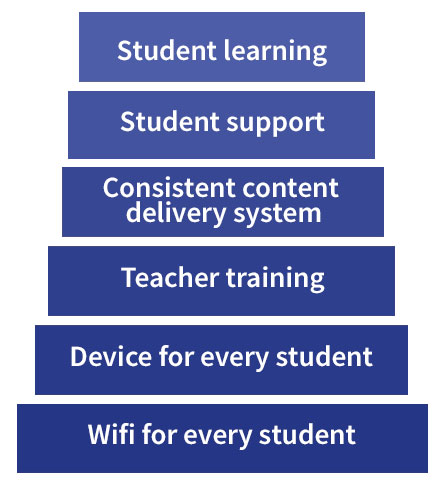
Completely In-Person School Year

Some schools are planning to keep their usual school calendar and return to completely in-person learning. This may be more common in areas with little or no community transmission of the virus.
The normalcy of returning to a regular school schedule is something many students, teachers, and parents want. It may be the most comfortable and require the least amount of change, but it’s not without risk.
To mitigate potential risk of spreading COVID-19, schools returning to a fully in person school year are implementing strict hygiene measures. These could include temperature checks, frequent hand washing, mask-wearing, disinfecting surfaces often, and social distancing.
A Hybrid School Schedule

A hybrid school schedule is similar to the idea of blended learning, and it’s an adaptable approach that can fit a variety of school needs.
What does it look like? Typically, during any given school week, students would attend school in person for a portion of the week, and attend the remainder remotely.
This hybrid in-person/at-home approach is increasingly popular among many districts. While it will still require that schools ensure all students have what they need to succeed at remote learning, it offers schools more flexibility. It also means students and teachers will get that much-missed time face to face.
Students who are at high risk and those who need more targeted support, like students with disabilities and English language learners, can be prioritized to attend school in person. Additionally, a hybrid school schedule, if planned right, equips schools with the ability to move to all-remote learning if the need arises.
A Staggered Schedule
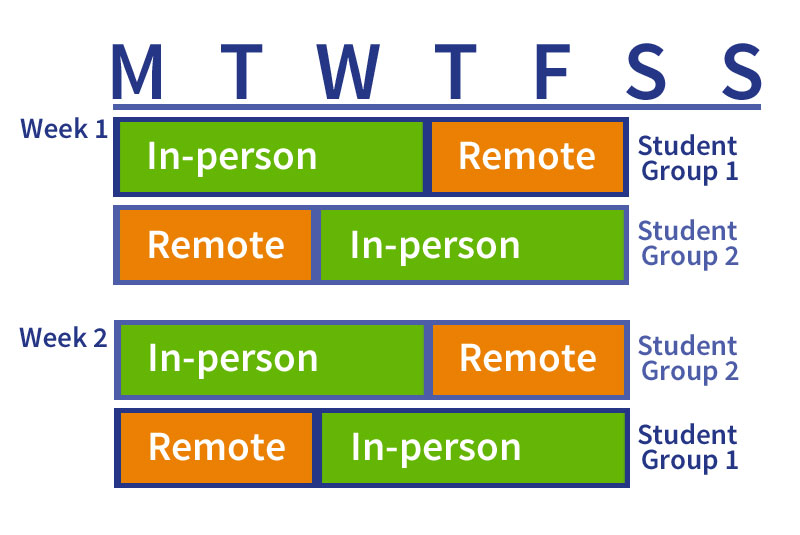
This option is often a component of a hybrid schedule, and explains how schools using a hybrid schedule may choose to structure their time.
Think of a staggered schedule like shift work, or the current A/B and rotating schedules many schools already have in place. To maintain proper social distancing, class sizes will need to be smaller. To accommodate this and reduce risk of infection, a staggered schedule will have one ‘shift’ of students attending class three days of the week, and another ‘shift’ on the remaining days. The next week the days would flip, so students would be attending school for the same amount of time.
Or, one group could attend Monday and Wednesday, another group Tuesday and Thursday, and both groups would complete schoolwork from home on Fridays. Some schools may even consider staggering the school day itself, some students attending in the morning and others in the afternoon. As you can see, this staggered approach gives schools a lot of options for managing time and keeping class sizes small.
Monday Through Saturday Schedule

Some schools are extending the school week into the weekend. Why? As has been discussed, many schools will be reducing class sizes, whether they are returning to school gully in-person or adopting a hybrid schedule.
In order for all students to meet with teachers and attend all of their classes, when fewer of them can be in those classes at once, something has to give. So, to create extra time, some schools will be open on Saturdays, although this could be for a shorter day or a remote learning day.
Increasing the amount of days allotted for learning during the week could mean shorter days overall, which may be especially beneficial for students who are doing remote learning, or schools utilizing a hybrid schedule.
Year-Round Schedule
The idea of going to school all year round may not be the most popular. But the reality is that it doesn’t have to be as monotonous as it sounds.
In some districts, they aren’t actually extending school all year round, but simply adding 20 days or so to the school calendar. But some really are taking the plunge to a year-round approach.A year-round schedule would likely include more frequent breaks during the year, and possibly a month-long break in the summer.
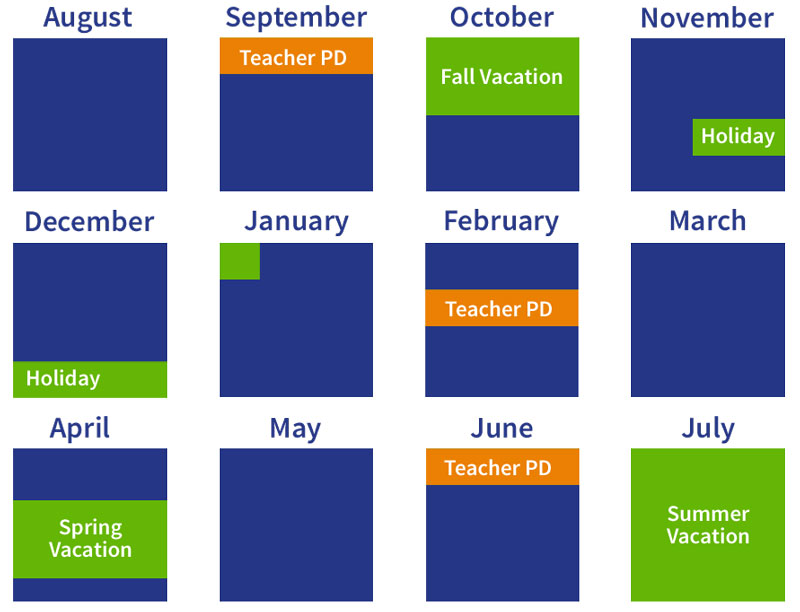
The above school calendar is just a sample of how time during the year could be structured. The blue represents regular instructional days, with more frequent school vacations and built in professional development. Time for Professional Development could be built into the school year for a week or so at a time, while students could work on independent projects.
The advantages to this is that it gives teachers considerably more time to teach, to plan and collaborate, and ensure they are providing intervention and enrichment for students.
Schedules with Student ‘Bubbles‘
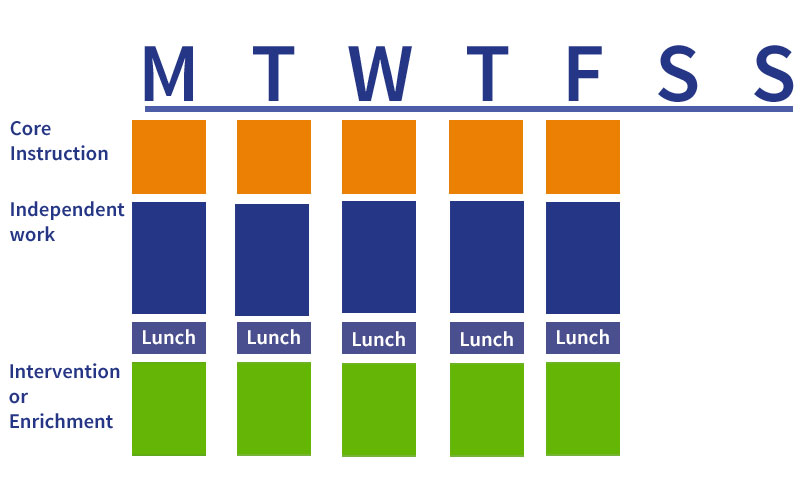
One idea some districts are implementing is creating student ‘bubbles.’ Small groups of students that will be assigned the same teacher all year round. They will be taught all subjects with this teacher and same group of students, each lunch with them, etc.
The school day could be broken up into various subject as usual, but some schools may choose to dedicate an entire day or portion of the day to a specific subject.
This naturally sounds like it could fit with an elementary school. However, in middle and high schools learning could be more independent and student-led, think Project-Based Learning, letting students take a deep dive into a subject area with the teacher filling a primarily supportive rather than instructive role.
The benefit of this approach is that these small groups will be confined in a way that makes the spread of the virus difficult to the entire school population. It is certainly not traditional, but for schools that already utilize a project-based or independent learning approach, this is a viable option.
Teacher Rotation
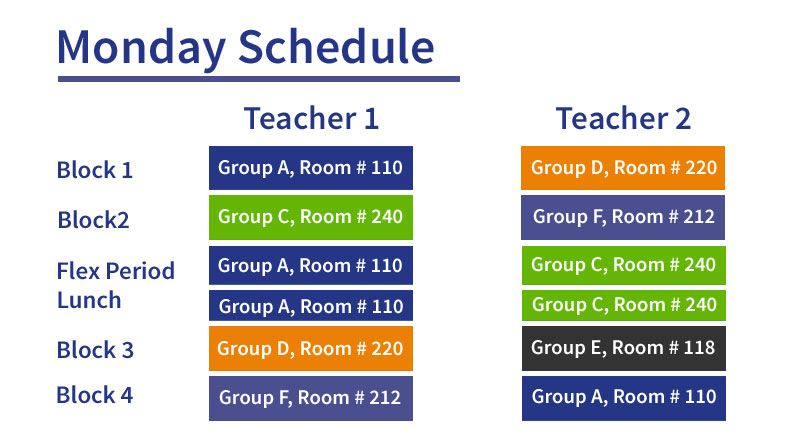
Another option, similar to creating a ‘bubble’ is for students to remain with the same small group all year, but have different teachers. Instead of the traditional middle and high school approach where students go from one class to another each period, this type of rotation would have teachers moving from class to class.
In the example above, you can see a schedule for two different teachers on the same day for a school using a 4×4 block schedule with a flex period for intervention and enrichment. Note that the groups represent different groups of students (Group A, Group B, etc.) and that their location during the day doesn’t change. Instead, teachers move from group to group.
Since the groups of students will be smaller, and students will not be interacting with other large groups, this could cut down on any viral transmission.
Mix and Match
There are certainly a lot of options schools are considering. And each of them can be bent and molded to fit the needs of different schools, perhaps taking pieces from each model and combining them into something new. It’s almost like choosing items from an a la carte menu.
Consider one option: A hybrid model with station rotation. In this approach, students would meet at school only a few days out of the week. Instead of just splitting the school population into two groups, students could be organized into more, and smaller groups or ‘bubbles’ assigned to one teacher. A school could even adopt this method and extend to year-round learning.
Pros and Cons
Even if your school isn’t changing it’s schedule, things are still going to change. What could this change mean? Well, there’s the bad change, and then there’s the good.
The bad: staff cuts, staff with two or more roles, lack of PD for teachers, zero or reduced school assemblies and field trips, resources spent on extra cleaning and safety measures like masks etc., child-care stresses for parents,
The good: Finding new ways to do things can lead to solutions no one thought of before. Sometimes things are done a certain way because, well, they’ve always been done that way. This school year, that mindset going out the window. A complete severance from tradition means thinking of new ways to help students learn.
Don’t devalue one-on-one support.
We’re going to use a tired phrase here because we really mean it: now more than ever, students need personalized support. And not just to close learning gaps. In one way or another, this school year as we knew it came to an abrupt end, adding to or creating feelings of loss and helplessness for students. They couldn’t see their friends, their teachers, participate in big events. Their lives were turned upside-down, and for many, that meant being stuck in a home that was unsafe.
So yes, now more than ever, students are going to need social and emotional support. This cannot be left out of the school schedule.
Change is scary, especially when you didn’t see it coming. The drawbacks to this situation come in loud and clear, and we’re not trying to gloss over them. But if students, and what is best for them, is truly kept front and center, it could lead to their best learning yet.








